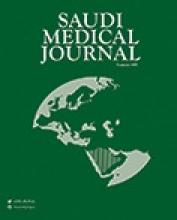Abstract
OBJECTIVE: Bilateral breast cancer is uncommon (1-2.6% of all patients with breast carcinoma). There are conflicting reports and inadequate data regarding the incidence and survival of such patients. This study examined the frequency, mode of detection, therapeutic modalities and histological features among the 2 breasts.
METHODS: Medical records of patients who were treated for breast cancer were reviewed at Khartoum Teaching Hospital, Sudan during a 5-year period of 1994 to 1999. Data of patients found to have bilateral breast cancer was analyzed focusing on the demographic information, family history, menstrual status, surgical therapy, chemoradiation, staging and histopathological characteristics.
RESULTS: Of 521 patients treated for breast cancer, 90 (17.2%) were reported to have advanced breast carcinoma (stage III, IV) and 7 (1.3%) revealed bilateral cancer: 5 (0.9%) synchronous and 2 (0.4%) metachronous breast cancer. The median age was 47.3 years (range, 24-81 years). Four (57.1%) patients had positive family history for breast cancer. First breast cancer was detected by mammogram in 2 cases while second cancer was diagnosed by the same study in 5 patients. Five (71.5%) underwent mastectomy and 2(28.5%) were treated by lumpectomy and axillary dissection. Six patients presented with stage III and one with stage IV breast cancer. Invasive ductal carcinoma was reported to be the most common type found in 10(71.5%) breasts. Grade III breast carcinoma was revealed in 9 and Grade I cancer in 3 specimens.
CONCLUSION: Bilateral breast cancer is invariably advanced when diagnosed. Mammogram is a valuable tool in early detection. Whether synchronous or metachronous, both breasts often share the same histological type.
- Copyright: © Saudi Medical Journal
This is an open-access article distributed under the terms of the Creative Commons Attribution-Noncommercial-Share Alike 3.0 Unported, which permits unrestricted use, distribution, and reproduction in any medium, provided the original work is properly cited.






